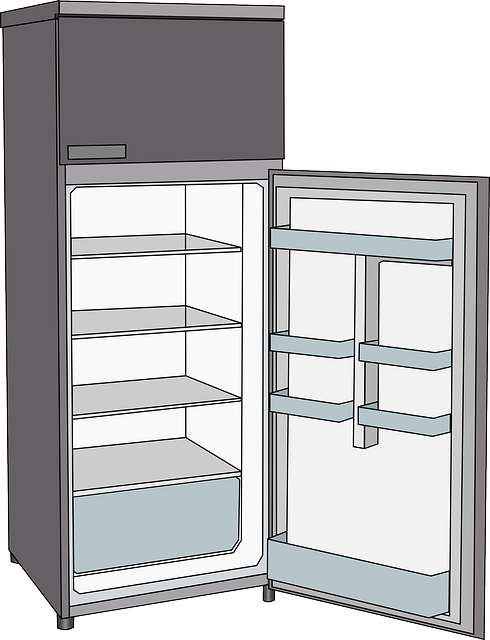To ensure your refrigerator operates efficiently and keeps food fresh, regular inspection and maintenance of the door seal are crucial. A faulty or worn-out seal can lead to significant energy loss and higher utility bills due to the fridge working harder to maintain its temperature. Homeowners should routinely check the door gasket for cleanliness and any signs of damage, as a loose or cracked seal allows air to leak in or out. If light passes through the frame when the door is closed, or if the seal feels too loose, it's time for repair or replacement. Minor issues can often be resolved with cleaning, but extensive damage typically requires a new seal, which can be installed as a DIY project if you have the right skills, or by a professional for guaranteed precision. Remember, when the rubber meets the road—or the door frame, in this case—regular maintenance and timely replacement of the door seals can save you money on your energy bills and keep your food fresh. This is a fundamental aspect of refrigerator repair that contributes to both energy efficiency and appliance longevity.
Ensuring your refrigerator operates efficiently is pivotal in maintaining both your food’s freshness and your energy costs manageable. This article delves into the essential aspects of door seal repair and replacement, a critical factor in preventing unwanted energy loss. We’ll guide you through assessing the integrity of your fridge’s seals, offer practical steps for common repair issues, help you understand when professional replacement might be necessary, and reveal how maintaining these seals can significantly enhance energy efficiency. By following our expert tips and maintenance strategies, you’ll keep your refrigerator in top condition, saving energy and money over time. Learn the intricacies of refrigerator repair and take decisive steps to safeguard your appliance’s performance.
- Assessing the Seal of Your Refrigerator: Signs It's Time for Repair or Replacement
- Step-by-Step Guide to Repairing Common Door Seal Issues in Refrigerators
- When to Opt for a Replacement: Understanding the Limitations of DIY Repairs on Refrigerator Door Seals
- Energy Efficiency Gains from Properly Maintained Refrigerator Door Seals and Tips for Long-Term Maintenance
Assessing the Seal of Your Refrigerator: Signs It's Time for Repair or Replacement

When it comes to maintaining energy efficiency and ensuring your food stays fresh, assessing the seal on your refrigerator is crucial. A compromised seal can lead to significant energy loss and even cause your fridge to work harder than necessary, ultimately driving up your utility bills. To determine if your refrigerator’s seal requires repair or replacement, look for several telltale signs. Firstly, check if the door gaskets are clean and free of debris or buildup that could prevent a proper seal. Any visible cracks or wear along the edges of the gasket can disrupt its ability to create an airtight seal. Additionally, when you close the refrigerator door, it should latch shut without much effort and not leave any daylight at the frame. If light shines through or the door doesn’t close properly, this is indicative of a seal issue that needs attention. Regularly inspecting and cleaning the gasket can prolong its lifespan, but if you notice persistent gaps or the rubber has deteriorated beyond repair, it may be time to replace the entire seal. Refrigerator repair often involves addressing such seals to restore functionality and efficiency, which is why homeowners should be vigilant about their maintenance. By staying proactive with these checks, you can prevent energy loss and ensure your refrigerator operates at peak performance.
Step-by-Step Guide to Repairing Common Door Seal Issues in Refrigerators

When encountering common door seal issues in refrigerators, timely repair is crucial to maintain optimal energy efficiency and food freshness. A faulty door seal can lead to significant energy loss, causing your refrigerator to work harder and increasing your utility bills. To address this, follow a step-by-step guide tailored for refrigerator repair:
Begin by visually inspecting the door seal for any obvious signs of damage or wear, such as cracks, tears, or detachment from the door frame. Gently insert a dollar bill into the seal around the perimeter of the door to check for a proper seal. If the bill slides out easily without resistance, this indicates the seal is not tight enough and needs adjustment or replacement.
Should you find that the seal requires repair, start by cleaning it thoroughly with warm soapy water to remove any debris or buildup that may have compromised its integrity. After cleaning, check for any broken rubber or metal pieces that need to be fixed or replaced. If minor damage is present and the seal is still pliable, you might be able to bend it back into shape using a door seal repair tool or a similar instrument designed for this purpose. However, if significant damage or detachment is observed, it’s advisable to replace the entire door seal. To do so, remove the old seal by carefully cutting it at the ends with a utility knife, being careful not to harm the refrigerator door. Then, gently slide out the old seal and install the new one, ensuring it is properly aligned along the grooves of the door frame. Reattach any clips or fasteners that hold the seal in place, and test the new seal by closing the door firmly and trying the dollar bill test again. With the door seal repaired or replaced, your refrigerator should once again maintain optimal temperatures, ensuring energy efficiency and preserving your food’s freshness.
When to Opt for a Replacement: Understanding the Limitations of DIY Repairs on Refrigerator Door Seals

When refrigerator door seals become compromised, homeowners often consider do-it-yourself repairs as a cost-effective solution. While minor damage to door seals can sometimes be remedied with simple fixes such as cleaning, reattaching, or adding weather stripping, these DIY measures are not always sufficient for extensive wear and tear. Over time, repeated use can lead to hardened rubber or damaged vinyl that resists repair attempts. Recognizing the limitations of DIY repairs is crucial when dealing with aged door seals on refrigerators. A seal that has deteriorated beyond a certain point will not maintain an effective barrier against air and moisture flow, leading to increased energy consumption and potential food spoilage. This is where professional replacement services come into play. Specialized knowledge and tools are often required to install new door seals correctly, ensuring optimal performance and energy efficiency. Moreover, attempting to replace a seal without the proper expertise can result in improper fit and further energy loss. Therefore, understanding the signs of irreparable damage and knowing when to opt for a professional replacement is essential for maintaining the efficiency of your refrigerator. Regular inspection and timely replacement of door seals by a skilled technician can prevent significant energy loss and prolong the lifespan of your appliance.
Energy Efficiency Gains from Properly Maintained Refrigerator Door Seals and Tips for Long-Term Maintenance

Regular maintenance of refrigerator door seals is a critical aspect for maintaining energy efficiency and ensuring your appliance operates effectively. Properly maintained door seals prevent cold air from escaping and hot air from entering, which is essential for optimal refrigerator performance. This not only keeps your food fresher for longer but also reduces the strain on your refrigerator’s compressor, ultimately leading to energy savings. A compromised seal can lead to significant energy loss, as the appliance must work harder to maintain the desired temperature within the unit. In fact, studies have shown that up to 25-35% of refrigerator and freezer energy is used to compensate for poor seals. To address this, it’s advisable to periodically inspect the door gasket for any signs of wear, such as cracks or deformation. Should you detect any issues, a simple repair using a gasket replacement kit can restore its functionality. Additionally, cleaning the seal with warm, soapy water and a non-abrasive cloth regularly helps maintain its flexibility and effectiveness. For long-term maintenance, consider the material of your door seal; some materials like silicone are more resilient to temperature changes and therefore may require less frequent replacement. By adhering to these maintenance tips, you can ensure your refrigerator door seals remain effective, thereby contributing to significant energy savings and a more efficient home environment.
Effective maintenance of your refrigerator’s door seal is pivotal in safeguarding against energy loss, as discussed. Regular assessments can alert you to potential issues before they escalate, allowing for timely repairs or replacement. Our step-by-step guide has equipped you with the necessary skills to address common door seal problems. However, it’s crucial to recognize when a repair may only be a temporary fix, and a replacement is the more sustainable option. By prioritizing the integrity of your refrigerator’s door seal, you not only extend its lifespan but also reap substantial energy efficiency benefits. Adhering to our maintenance tips will ensure your refrigerator operates optimally for years to come. Remember, refrigerator repair is a continuous process, and staying vigilant can lead to significant savings on your energy bills.
